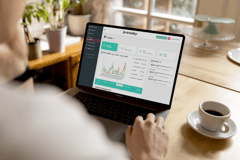Decisions, decisions. When it comes to your organization’s video content, is it best to maximize quality, or to really hone in on the message itself? Sure, in a perfect world, you could throw the kitchen sink at both. But, alas, this isn’t a perfect world, so compromise is usually inevitable when creating and generating truly engaging video content.
The good news, however, is that the decision isn’t nearly as stark as it might seem. In fact, it’s really a matter of finding that ideal balance between video quality and your video message. And I have a few tips to help you walk that challenging but crucial tightrope toward maximum engagement no matter the circumstances.
Sending the Right Message
When most people think about video content, visual aesthetics are usually first in mind, and there's nothing wrong with that. After all, video is a visually-driven medium. Note, however, how I didn't say video is exclusively a visually-driven medium. Because as important as aesthetics are to your content, they're still not going to drive engagement without an underlying message that informs and educates the viewer.
Unfortunately, getting too tied up with aesthetics often means that essential underlying message takes second fiddle, often even getting lost in the mix. For example, you can have the best-looking video content in your industry, but if you haven't included a decisive call to action, your audience will have no idea what to do next. And that, much to your sales department’s chagrin, usually means they'll do nothing, undermining the very reason your sales and marketing campaigns exist in the first place.
Therefore, before you even start to plan out the visual aspects of your video content, I suggest initially focusing on the purpose of the video.
What are you trying to convey?
What are you trying to accomplish?
What do you want the audience to do after watching your video?
Answering these questions will create a framework you can build around, including for your visuals. This way, it makes it easier to find that balance between quality and messaging, aesthetics and information.
Also, to generate even more engagement – deeper connections with the viewer – I suggest personalizing your video content wherever and whenever possible. In other words, speak to the person, not at them, using inclusive language that creates a sense of familiarity and comfort.
Improving the Quality of Your Video Content
None of that is to say, of course, that the message is more important than quality. Because if something is off with your video aesthetics, it can quickly turn your content into a sinking ship with exactly zero engagement for your troubles. Thus, I have a number of quick and easy best practices to keep in mind as you create your videos.
- Be intentional and authentic, remembering that it's okay to be imperfect. As a matter of fact, the audience usually finds such small imperfections human and endearing.
- Practice makes perfect. Very few of us immediately feel comfortable in front of a camera. However, even the most camera-shy of people can make huge strides, as long as they practice their style and delivery.
- Put the ‘why’ of the video on display. Make your purpose behind the content big and bold, like a metaphorical neon sign the audience can't miss.
- Don't sweat your equipment. No one is expecting Spielberg from your video content. Most modern smartphones can take high-quality video while also feeling more personal and intimate to your audience.
- Sound is a critical component. No matter how beautiful your video might be or appealing your message, if the viewer can't hear what you're saying, you’re just spinning your wheels.
- Building on the previous step, the closer you are to the mic, the clearer you will sound. This is especially important in loud, busy environments.
- Natural light is your best friend, ideally as your face points toward the light to avoid excessive shadows.
- Overcast days are best for outdoor shooting, providing a softer, usually more flattering light for your subjects.
- Keep the camera as level and sturdy as possible, stabilizing it when you can.
- Slow camera movement is always best for a virtual tour. Remember, our eyes are slower to react than the camera lens, so give your audience ample time to absorb what's in front of them.
Using OneDay for Your Video Content
Now that we've discussed some best practices for video quality and messaging, let's take a deeper dive and see how OneDay can help you improve both.
First and foremost, the platform's editing features can clean up a lot of the mess-ups in your recordings, also helping you make your content more informative and concise. For example, you can use OneDay to quickly trim any fluff from your videos so they’re always crisp and on point for the viewer.
Also, if you're in a pinch and need to make a quick but professional-looking video, our web recorder beta feature could be just what you need. With this option, you don't have to worry about maintaining a steady camera since the web recording does everything for you. This feature is particularly beneficial for employee shoutouts or simply practicing your on-camera skills.
Final Thoughts
Granted, while keeping this deluge of best practices in mind can only improve your video content, I understand adhering to all of them isn't always possible. To that point, if you have to pick and choose what to devote the bulk of your time and energy on, I suggest letting the subject matter lead the way.
In other words, if you’re trying to convey specific information – details on an upcoming event, answering a customer question, or anything primarily verbal – then it's usually best to concentrate on the message. Alternatively, if you’re showing off a new resident building or community feature, then visual quality should be your priority.
Either way, never forget to provide a call to action for the audience since they'll usually need a sense of direction to proceed along the customer journey. And as you go, our team at OneDay is always here to help your video content make maximum impact at every turn.




